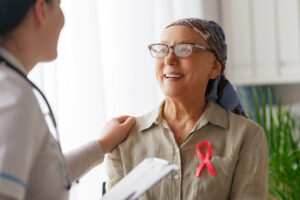Samaritan is a proud provider of Dementia Care and uniquely distinguished as a GUIDE provider by the Centers for Medicare and Medicaid (CMS). Click to learn more.
(856) 596-1600 available 24/7 Refer Now
 Breast cancer is a complex disease that affects millions of people worldwide. While the exact causes of breast cancer are not fully understood, there are several known risk factors that can increase a person’s chances of developing the disease.
Breast cancer is a complex disease that affects millions of people worldwide. While the exact causes of breast cancer are not fully understood, there are several known risk factors that can increase a person’s chances of developing the disease.
One of the primary risk factors for breast cancer is age. The risk of developing breast cancer increases as a person gets older, with most cases occurring in women over the age of 50. Other risk factors include a family history of breast cancer, certain genetic mutations, hormonal factors such as early menstruation or late menopause, and exposure to estrogen.
Breast cancer symptoms may vary, but the most common sign is a lump or thickening in the breast or underarm area. Other symptoms may include changes in the size or shape of the breast, nipple discharge, skin changes, or pain in the breast or nipple. It is important to note that not all lumps or changes in the breast are cancerous, but it is crucial to consult a healthcare professional for further evaluation if any abnormalities are noticed.
Below are several helpful resources for breast cancer patients and those interested in learning more. If you have any other questions, please content Samaritan: (856) 596-1600
Early detection through regular breast self-exams, clinical breast exams, and mammograms is crucial in increasing the chances of successful treatment. It is important for individuals to be proactive about their breast health and to consult a healthcare professional if they notice any changes or abnormalities. With advances in research and treatment, the prognosis for breast cancer has improved significantly over the years, and many individuals are able to live long and fulfilling lives after diagnosis.
 Breast Cancer Care Begins with the Moment of Diagnosis
Breast Cancer Care Begins with the Moment of DiagnosisWhen it comes to treating breast cancer, there are several options available depending on the stage of the disease and individual factors. Surgery is often the primary treatment for breast cancer and may involve removing the tumor, surrounding tissue, or the entire breast. Other treatment modalities include radiation therapy, chemotherapy, hormone therapy, targeted therapy, and immunotherapy. The treatment plan is determined by a multidisciplinary team of healthcare professionals and is tailored to each patient’s specific needs.
Many people don’t understand palliative care and the benefits it has to offer those with serious illnesses, including breast cancer. If you are one of those people, you’re not alone.
Palliative care is health care designed to improve both the lives of patients with a serious illness and their families and can be used across the full spectrum of breast cancer care, from initial diagnosis through treatment, and, if necessary, through hospice care and bereavement.
Palliative care offers an extra layer of breast cancer help focused on relieving symptoms and side effects related to serious illness. In breast cancer, palliative care is often appropriate as early as your initial diagnosis and treatment.
A team of palliative care experts helps you communicate your goals and wishes for your treatment and care. They make sure your care is coordinated among your clinical providers, and they provide expert care to control any symptoms and discomfort you may experience during treatment, such as nausea, pain, and fatigue. Controlling these symptoms is a vital part of your treatment, and you should never hesitate to tell your Samaritan care team about any symptoms or pain you are experiencing.
Palliative care is also crucial for patients with metastatic breast cancer. Again, a main focus of palliative care is the prevention and management of side effects and symptoms, but palliative care also helps patients and their families holistically, by addressing emotional and spiritual issues, encouraging conversations around the topics of treatment decisions and goals, and accessing grief counseling.
 Getting the Most from Palliative Care
Getting the Most from Palliative CarePalliative care works best when it is integrated early in your breast cancer care. We encourage patients and their families to be proactive about asking their oncology team for a palliative care consult to help with symptom management, care planning, and support for the entire family.
In addition to medical treatments, the best advice for breast cancer patients also includes lifestyle changes which play a role in managing breast cancer. Your palliative care team will help you navigate and understand which lifestyle changes area appropriate for you. These include maintaining a healthy weight, exercising regularly, eating a balanced diet, limiting alcohol consumption, and avoiding tobacco products.
At Samaritan, our palliative medicine team is by your side at every step of your breast cancer journey. Your care team includes a physician, an advanced practice nurse, and a social worker. Our mission is to help you navigate conversations and care decisions, manage symptoms and side effects, coordinate care among specialists and treatment teams, and ensure your emotional and spiritual needs are met.
For more breast cancer resources and/or palliative care advice, contact Samaritan 24/7: (856) 596-1600
Hospice care is a specific type of palliative care typically provided when a patient’s life expectancy is six months or less. A person enrolled in hospice care may survive longer, and hospice care will continue. Hospice care focuses on providing comfort, support, and dignity, and is provided wherever the patient calls home and is most comfortable.
Your Samaritan hospice team includes a physician, nurse, social worker, home health aide, music therapist, massage therapist, spiritual care counselor, and volunteers who will spend time with you. The cost of hospice care is covered by Medicare, Medicaid, and most insurance companies and plans. Equipment and supplies, including hospital beds, shower chairs, and all medicines which are part of your hospice treatment, are provided for you. While curative treatments for your breast cancer will stop once you enter hospice care, treatments to improve the quality of your life and ease your symptoms will continue.
The primary goal of hospice care is to allow you to live as fully and comfortably as possible, while we provide support for your family and loved ones. Hospice care focuses on symptom management and pain control while also:

At Samaritan, every step of your healthcare journey is built upon your treatment wishes and goals. Your hospice care is no different. Listening to you is at the heart of all we do.
Our promise to you is patient-centered, compassionate, expert care that allows you and your loved ones to live your best lives every day.
Because the causes of breast cancer are not fully known, there are many myths about the disease. Learn the truth here.
FACTS:
Visit komen.org for safe, accurate and current breast cancer resources.